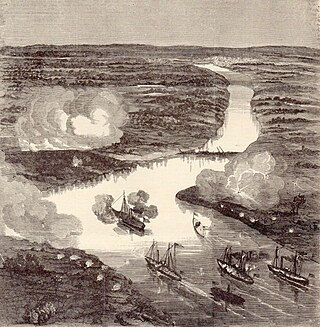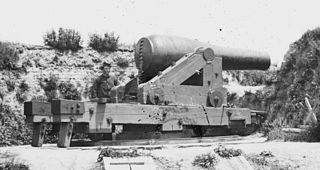
The Richmond–Petersburg campaign was a series of battles around Petersburg, Virginia, fought from June 9, 1864, to March 25, 1865, during the American Civil War. Although it is more popularly known as the siege of Petersburg, it was not a classic military siege, in which a city is encircled with fortifications blocking all routes of ingress and egress, nor was it strictly limited to actions against Petersburg. The campaign consisted of nine months of trench warfare in which Union forces commanded by Lieutenant General Ulysses S. Grant assaulted Petersburg unsuccessfully and then constructed trench lines that eventually extended over 30 miles (48 km) from the eastern outskirts of Richmond, Virginia, to around the eastern and southern outskirts of Petersburg. Petersburg was crucial to the supply of Confederate General Robert E. Lee's army and the Confederate capital of Richmond. Numerous raids were conducted and battles fought in attempts to cut off the Richmond and Petersburg Railroad. Many of these battles caused the lengthening of the trench lines.

The Peninsula campaign of the American Civil War was a major Union operation launched in southeastern Virginia from March to July 1862, the first large-scale offensive in the Eastern Theater. The operation, commanded by Major General George B. McClellan, was an amphibious turning movement against the Confederate States Army in Northern Virginia, intended to capture the Confederate capital of Richmond. Despite the fact that Confederate spy Thomas Nelson Conrad had obtained documents describing McClellan's battle plans from a double agent in the War Department, McClellan was initially successful against the equally cautious General Joseph E. Johnston, but the emergence of the more aggressive General Robert E. Lee turned the subsequent Seven Days Battles into a humiliating Union defeat.

The Battle of Drewry's Bluff, also known as the Battle of Fort Darling, or Fort Drewry, took place on May 15, 1862, in Chesterfield County, Virginia, as part of the Peninsula Campaign of the American Civil War. Four Union Navy warships, including the ironclads USS Monitor and Galena, and the United States Revenue Cutter Service's ironclad USRC Naugatuck steamed up the James River to test the defenses of Richmond, Virginia, the Confederate capital. They encountered submerged obstacles, and the batteries of Fort Darling at Drewry's Bluff inflicted severe damage on Galena, forcing the ships to turn back.

The Battle of Hanover Court House, also known as the Battle of Slash Church, took place on May 27, 1862, in Hanover County, Virginia, as part of the Peninsula Campaign of the American Civil War.

Drewry's Bluff is located in northeastern Chesterfield County, Virginia, in the United States. It was the site of Confederate Fort Darling during the American Civil War. It was named for a local landowner, Confederate Captain Augustus H. Drewry, who owned the property.

Fort Darling was a Confederate military installation during the American Civil War located at Drewry's Bluff, a high point of 80–100 feet overlooking a bend in the James River south of Richmond in Chesterfield County, Virginia. It protected the Confederate capital of Richmond from Union naval attacks throughout most of the war.

The Battle of Chaffin's Farm and New Market Heights, also known as Laurel Hill and combats at Forts Harrison, Johnson, and Gilmer, was fought in Virginia on September 29–30, 1864, as part of the siege of Petersburg in the American Civil War.

The Second Battle of Petersburg, also known as the assault on Petersburg, was fought June 15–18, 1864, at the beginning of the Richmond–Petersburg Campaign. Union forces under Lieutenant General Ulysses S. Grant and Major General George G. Meade attempted to capture Petersburg, Virginia, before General Robert E. Lee's Confederate Army of Northern Virginia could reinforce the city.

The Battle of Petersburg was an unsuccessful Union assault against the earthworks fortification, the Dimmock Line, protecting the city of Petersburg, Virginia, June 9, 1864, during the American Civil War. Because of the ragtag group of defenders involved, it is sometimes known as the Battle of Old Men and Young Boys.
The Battle of Wilson's Wharf was a battle in Union Lt. Gen. Ulysses S. Grant's Overland Campaign against Confederate Gen. Robert E. Lee's Army of Northern Virginia.

The Battle of Totopotomoy Creek, also called the Battle of Bethesda Church, Crumps Creek, Shady Grove Road, and Hanovertown, was fought in Hanover County, Virginia on May 28–30, 1864, as part of Union Lt. Gen. Ulysses Grant's Overland Campaign against Confederate Gen. Robert E. Lee's Army of Northern Virginia.

The Bermuda Hundred campaign was a series of battles fought at the town of Bermuda Hundred, outside Richmond, Virginia, during May 1864 in the American Civil War. Union Maj. Gen. Benjamin Butler, commanding the Army of the James, threatened Richmond from the east but was stopped by forces under Confederate Gen. P.G.T. Beauregard.

The Richmond National Battlefield Park commemorates 13 American Civil War sites around Richmond, Virginia, which served as the capital of the Confederate States of America for most of the war. The park connects certain features within the city with defensive fortifications and battle sites around it.

The Battle of Peebles' Farm was the western part of a simultaneous Union offensive against the Confederate works guarding Petersburg and Richmond, Virginia, during the Siege of Petersburg in the American Civil War.

Chaffin's Bluff is located in Henrico County, Virginia, United States, on the north side of the James River, opposite Drewry's Bluff, long-considered a major defense point of the river below Richmond. Located at a major bend in the river about eight miles south of Richmond, both bluffs were fortified by the Confederates early in the American Civil War.
The Battle of Chester Station was fought on May 10, 1864, between Union and Confederate forces during the American Civil War. The Confederates attacked portions of Benjamin Butler's Union forces.
The Second Battle of Deep Bottom, also known as Fussell's Mill, New Market Road, Bailey's Creek, Charles City Road, or White's Tavern, was fought August 14–20, 1864, at Deep Bottom in Henrico County, Virginia, during the Richmond-Petersburg Campaign of the American Civil War.

The First Battle of Deep Bottom, also known as Darbytown, Strawberry Plains, New Market Road, or Gravel Hill, was fought July 27–29, 1864, at Deep Bottom in Henrico County, Virginia, as part of the Siege of Petersburg of the American Civil War. A Union force under Maj. Gens. Winfield S. Hancock and Philip H. Sheridan was sent on an expedition threatening Richmond, Virginia, and its railroads, intending to attract Confederate troops away from the Petersburg defensive line, in anticipation of the upcoming Battle of the Crater. The Union infantry and cavalry force was unable to break through the Confederate fortifications at Bailey's Creek and Fussell's Mill and was withdrawn, but it achieved its desired effect of momentarily reducing Confederate strength at Petersburg.

The Battle of Darbytown and New Market Roads was an engagement between Union and Confederate forces during the American Civil War, which took place on October 7, 1864, in Henrico County, Virginia, as part of the Richmond-Petersburg Campaign.

The Howlett Line was a critical Confederate earthworks dug during the Bermuda Hundred Campaign of the United States Civil War in May 1864. Specifically, the line stretched across the Bermuda Hundred peninsula from the James River to the Appomattox River. It was named for the Dr. Howlett's House that overlooked the James River at the north end of the line. The Howlett Line became famous as the "Cork in the Bottle" by keeping the 30,000-man strong General Butler's Army of the James at bay.


















